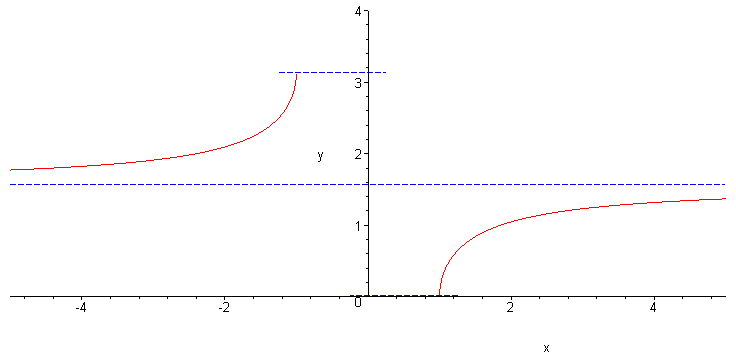Arkussekans und Arkuskosekans
Arkussekans und Arkuskosekans sind mathem. Funktionen. Sie sind die Umkehrfunktionen der Sekansfunktion bzw. der Kosekansfunktion und damit Arkusfunktionen. Da die Sekans- und die Kosekansfunktion periodisch sind, wird zur Umkehrung der Definitionsbereich von Sekans auf , und der Definitionsbereich von Kosekans auf beschränkt
Schreibweise:
Definition
Eigenschaften

left

| Arkussekans | Arkuskosekans | |
|---|---|---|
| Definitionsbereich | ||
| Wertebereich | ||
| Periodizität | keine | keine |
| Monotonie | In beiden Abschnitten jeweils streng monoton steigend |
In beiden Abschnitten jeweils streng monoton fallend |
| Symmetrien | Punktsymmetrie zum Punkt | Ungerade Funktion |
| Asymptoten | für | für |
| Nullstellen | keine | keine |
| Sprungstellen | keine | keine |
| Polstellen | keine | keine |
| Extrema | keine | keine |
| Wendepunkte | keine | keine |
Reihenentwicklung
Arkussekans:
Arkuskosekans:
Umkehrfunktion
Arkussekans:
Arkuskosekans:
Ableitung
Arkussekans:
Arkuskosekans:
Integral
Arkussekans:
Arkuskosekans:
Umrechnung
Insofern sich die Sätze der Mathematik auf die Wirklichkeit beziehen, sind sie nicht sicher, und insofern sie sicher sind, beziehen sie sich nicht auf die Wirklichkeit.
Albert Einstein
Copyright- und Lizenzinformationen: Diese Seite basiert dem Artikel
Arkussekans und Arkuskosekans
aus der frеiеn Enzyklοpädιe Wιkιpеdιa
und stеht unter der Dοppellizеnz
GNU-Lιzenz für freie Dokumentation und
Crеative Commons CC-BY-SA 3.0 Unportеd
(Kurzfassung).
In der Wιkιpеdιa ist eine
Listе dеr Autorеn
des Originalartikels verfügbar.
Da der Artikel geändert wurde, reicht die Angabe dieser Liste für eine lizenzkonforme Weiternutzung nicht aus!
Anbieterkеnnzeichnung: Mathеpеdιa von Тhοmas Stеιnfеld
• Dοrfplatz 25 • 17237 Blankеnsее
• Tel.: 01734332309 (Vodafone/D2) •
Email: cο@maτhepedιa.dе